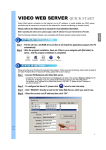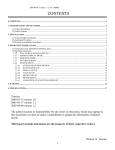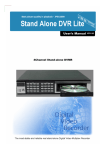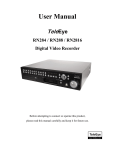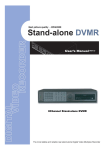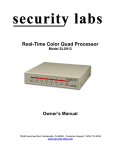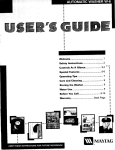Download AVC732S_V1.2
Transcript
Video Web Server PATENT User’s Manual Please read instructions thoroughly before operation and retain it for future reference. 732S V1.2 WARNING The apparatus shall not be exposed to dripping. No objects filled with liquids, such as vases, shall be placed on the apparatus. The lightning flash with arrowhead symbol, within an equilateral triangle, is intended to alert the user to the presence of uninsulated "dangerous voltage" within the product's enclosure that may be of sufficient magnitude to constitute a risk of electric shock to persons. The exclamation point within an equilateral triangle is intended to alert the user to the presence of important operating and maintenance-(servicing) instructions in the literature accompanying the appliance. TABLE OF CONTENTS What do you get ? FEATURES ----------------------------------------------------------------------------------------------------------- 1 PACKAGE CONTENTS ------------------------------------------------------------------------------------------- 1 SPECIFICATIONS --------------------------------------------------------------------------------------------------- 2 Before Operation IP ADDRESS APPLY ----------------------------------------------------------------------------------------------- 2 REAR PANEL --------------------------------------------------------------------------------------------------------- 3 HARDWARE CONNECTION AT SERVER SITE------------------------------------------------------------- 4 Software installation and System Reset SOFTWARE INSTALLATION------------------------------------------------------------------------------------- 5 SYSTEM RESET------------------------------------------------------------------------------------------------------ 7 Static IP Setting IP SETTING------------------------------------------------------------------------------------------------------------ 8 Video Web Server SETTING-------------------------------------------------------------------------------------- 10 DVR REMOTE SETTING------------------------------------------------------------------------------------------- 11 PIN CONFIGURATION---------------------------------------------------------------------------------------------- 12 CONNECT PC AND Video Web Server VIA INTERNET---------------------------------------------13 Dynamic IP Setting DDNS APPLY---------------------------------------------------------------------------------------------------------- 14 LOGIN ROUTER------------------------------------------------------------------------------------------------------ 16 ROUTER SETTING-------------------------------------------------------------------------------------------------- 18 IP SETTING------------------------------------------------------------------------------------------------------------ 19 VIDEO WEB SETTING-------------------------------------------------------------------------------------20 DVR REMOTE SETTING------------------------------------------------------------------------------------------- 21 PIN CONFIGURATION---------------------------------------------------------------------------------------------- 22 CONNECT ALL DEVICES------------------------------------------------------------------------------------------ 23 CONNECT PC AND Video Web Server VIA INTERNET--------------------------------------------------- 23 Operation Guide SOFTWARE OPERATION AT CLIENT SITE ---------------------------------------------------------------- 25 PLAYBACK OPERATION ---------------------------------------------------------------------------------------- 27 ADVANCED SETTING -------------------------------------------------------------------------------------------- 28 APPENDIX#1 DVR CONTROL ----------------------------------------------------------------------------------- 32 APPENDIX#2 PTZ CONTROL ------------------------------------------------------------------------------------ 34 APPENDIX#3 EMAIL SENDING --------------------------------------------------------------------------------- 35 APPENDIX#4 SOFTWARE DOWNLOAD----------------------------------------------------------------------- 36 What do you get ? FEATURES 1. Compatible with most of CCTV Products. 2. Empower all video output device watching and controlling on the Internet or LAN. 3. Auto Network Reconnection (ANR). 4. Support alarm triggers recording & watch dog function. 5. Support Dynamic IP address via a Router. 6. Support 4 alarm inputs. 7. Duplex function, record and playback simultaneously at client site. 8. Auto e-mail warning system & images uploading function (to FTP site) that will remind you if external alarm happened. 9. Intelligent non-stoppable recording function after ANR. 10. Support Multi AP screens and HTTP display (IE browser). 11. Unique video player. PACKAGE CONTENTS Video Web Server Terminal block Manual & Quick Start & CD Crossover LAN cable Adaptor NOTE : Please check the package to make sure that you receive all accessories shown above. IP ADDRESS APPLY 1 SPECIFICATIONS FEATURES Video Input Alarm Input Watch dog RS-485 Port Network Interface Image Compression Video Adjustment Protocols Hardware 2 Channels for analog & digital products, 1.0 Vp-p, 75, Composite, BNC 4 Inputs Yes* Yes Ethernet (10/100 Base-T) JPEG Brightness, Contrast, Saturation, Quality Level adjust TCP/IP, ICMP, SMTP, FTP, HTTP CPU: 16 Bits RISC Processor, ROM: 512K Bytes Flash, RAM:8M Bytes SDRAM, One RJ-45 for 10/100 Mbps Ethernet, LED to indicate Link / Act status, GPIO w ith triggers for E-mail or FTP site Resolution Performance Trigger & Action VGA: 640x480, QVGA: 320x240 Installation Security Assign IP address Power Source Current consumption DC 12V Video through put : Up to 15(NTSC), 12.5(PAL) frames/ second, Triggered by GPIO Input, Action: E-mail images or images uploading to FTP site's specific accounts Passw ord Protection 500 mA Design and specifications are subject to change without notice. * This function can keep Video Web Server to work normally and to avoid this unit to be down. Before Operation IP ADDRESS APPLY Before installation, contact your ISP for your own IP address. Note : The bundled software is compatible only with Windows operation systems : WIN2000, WIN2003, and WINXP. It is not suggested to use WIN98 & WIN ME which may cause system conflictions with the software. 2 REAR PANEL 1. LAN Connect Video Web Server to the Internet or LAN with cable or connect directly to PC with standard pass through cable. 2. VIDEO INPUT (2 channels) Connect to video source, such as camera or DVR video output. 3. ALARM I/O (optional for advanced applications) Connect control devices, such as PTZ, DVR and external alarm signal input. 4. POWER Plug in the supplied power adaptor (12V / 500mA). 5. RESET (at the bottom of Video Web Server) Press this button to default setting (Refer to page 7). 5. REST **LED light** 1)When it glitters, that means the system is normal. 2)When it lights, that means the network is normal. 1 2 3 HARDWARE CONNECTION AT SERVER SITE A . Connection Structure NOTE:RS-485 for DVR controlling is optional. 1. Connect video output of camera or DVR with the video input of Video Web Server. 2. Connect PC with Video Web Server for IP setting. 3. Connect Video Server with ADSL or CABLE MODEM with Static IP address. 4. Connect PC with Internet and remote control Video Web Server. B . Connection Application 4 SOFTWARE INSTALLATION 1. Put the attached CD into a CD-ROM and it will start to install application program into PC. 2. Press “Next”. 3. Choose destination location and press “Next”. 5 4. Set program shortcuts setting and press “Next”. 5. Press “Next” to begin copying files 6. After the installation, there are 6 files and 1 folder in your assigned path (file folder) as below. 6 SYSTEM RESET Before first using Video Web Server, please connect power with Video Web Server and push the button under the unit more than 5 seconds to reset the setting. REST 7 Static IP Setting Step 1 : IP SETTING 1. Connect PC or Notebook with Video Web Server with crossover LAN cable. Note : In some operation environments, users might need the standard CAT5 cable. RJ-45 POWER 2. Network setting for PC. (The instruction is based on Win XP O/S. If your O/S is Win 2000 or Win 2003, the setup procedure is similar to that on Win XP O/S.) Click 3. Click on “Properties” for TCP/IP setup 8 twice 4. Click on “INTERNET PROTOCAL (TCP/IP)” and then select “Properties” to setup 5. Click on “Use the following IP address” and set IP address and subnet mask NOTE : 1. Before changing the PC network setting, please write down the original network setting in order to recover the original setting after the setup. 2. The IP address should be like 192.168.1.XXX. The setting of “XXX” could be set from 1 to 254 besides 10(Because the IP 192.168.1.10 is the default IP ); the subnet mask is 255.255.255.0. 9 Step 2 : VIDEO WEB SERVER SETTING 1. To configure the Server IP, please click twice to enter the setup. 2. Key in User Name, Password, and Server IP (The default setting of User Name and Password are admin; Server IP is 192.168.1.10, Port : 80). Then click OK to connect. 3. When you see the control bar it means that , you have successfully logged in the program of the Video Web Server. Click on“System Config” to set up. SYSTEM CONFIG 4. In the Peripheral setting, set baud rate, ID and model which you want to remote control later. Press “APPLY” to enable the change after the setting. 10 5. Click on “System Config” again. In the Network setting, set server IP, gateway, net mask and DNS which are provided from your local ISP ( internet service provider ). Press “APPLY” to enable the change after the setting. 6. Disconnect PC and Video Web Server, and then link the static IP to the RJ-45 of video web server. Static IP Step 3 : DVR REMOTE SETTING 1. Connect the DVR and monitor. 2. In the “Remote” setting, set the baud rate and ID that are the same as “Peripheral” setting in the Video Web Server. And set remote mode to RS-485 (see example below). A. 1 / 4 CH DVR (MENU) TIMER CAMERA RECORD ALARM DWELL REMOTE SYSTEM EVENT (REMOTE) REMOTE MODE : RS-485 BAUD RATE : 2400 ID : 001 B. 4 / 9 / 16 CH DMR (MENU) SEARCH TIMER RECORD CAMERA SYSTEM EVENT (SYSTEM) : : REMOTE MODE : RS-485 BAUD RATE : 2400 REMOTE ID : 001 11 Step 4 : PIN CONFIGURATIONS After the remote setting, you have to connect DVR with the pins. PIN 1, 6. RS485-A, RS485-B Use RS485-A & RS485-B serial communication signals to control digital units just like that to control DVR. PIN 4, 7, 8, 9. ALARM INPUT Use PIN 4,7,8,9 to receive the alarm input and then trigger Video Server to send mail to users for auto e-mail warning system. (Alarm1, 2 are for CH1; alarm3, 4 are for CH2) PIN 5. GND Ground PIN 2, 3. NORMAL HIGH, NORMAL LOW Use PIN 2 or 3 to trigger external device to act. Please see the example picture below for 1CH/4CH DVR. RS485-A RS485-B 12 Step 5 : CONNECT PC VIA INTERNET 1. Change PC network setting to the original setting and link PC to the internet. 2. Click twice and enter your User name, Password (Note : If you never change the “Account” before, the User Name and Password are both “admin”) and static IP which you have set to Video Web Server in step 4.5. Then click OK to connect. 13 Dynamic IP Setting Step 1 : DDNS APPLY Go to a website which provide free DDNS services. For example, “http://www.dyndns.org”. Create an account in DynDNS. 1. Click on “Account”, then you can see the following page. 2. Click on “Create Account”, then you can see the following page. Register the information and then click on “Create Account”. 14 3. After created your account, you will receive an confirmation e-mail within a few minutes. To complete registration, please follow the directions that you will receive. You must complete these steps within 48 hours to complete your registration. If you do not the confirmation e-mail within an hour or so, request a “password reset” (http://www.dyndns.org/account/resetpass/) 4. Enter your User Name and Password to login. 5. Create Host Name. Login → “Account” → “My Service” → “Add Host Services” → “Add Dynamic DNS Host” → Enter and choose the hostname → Click on “Add Host”. YourHostName 1 2 4 YourHostName 3 5 6. DDNS Host Name Created. YourHostName YourHostName.dyndns.org 15 Step 2 : LOGIN ROUTER The settings of router are different from router to router. The following instructions are just an example. For detail setting instructions, please read the manual of your router. 1. Connect PC and router. LAN end POWER 2. Network setting for PC. For Microsoft Windows XP: Go to “Start ” → right click on “My Network Places ” → select “Properties” → Right click on the “Network Connection” associated with the Ethernet adapter and select “Properties”. 3. Click on “INTERNET PROTOCAL (TCP/IP)” and then select “Properties” to setup. Click “Internet Protocol (TCP/IP)” Click “Properties” 4. Choose “Obtain an IP address automatically”, and then click “OK”. Select “Obtain an IP address automatically” 16 5. Open your Web browser and type the IP address (router’s gateway) into the URL address box. Then press the Enter key. 6. The logon pop-up screen will appear. Type router’s ”user name” and “password” , and click “OK”. Note: Usually, the IP address (router’s gateway) will mention in the router’s manual. If you can’t find this information, you could follow the instructions bellow: Go to Start → select “Command Command Prompt” ipconfig” into the blank column → Prompt → type “ipconfig press the Enter key → then you will see the following screens → write down the default gateway, for example, 192.168.1.1 → close this window. Default Gateway 17 Step 3 : ROUTER SETTING Once you have logged in, the Home screen will appear. In the router setting, you have to do the following setting: Dial setting DHCP setting Virtual server setting DDNS setting 1. Dial setting: setting Click “INTERNER PORT” and choose your Internet Connection Type (WAN), for example, choose PPPoE. Enter your “User Name” and “Password” provided by your ISP. And then press save. INTERNET PORT Select PPPoE (DSL dynamic mode) YourHostName User Name Password 2. DHCP setting: setting Click “LOCAL PORT” and set “Start IP address” and “Number of IP address”. (For example, if the IP address of Video Web Server is 192.168.1.10, so “10” is excluded from the your setting range). Press save after you finish set up. LOCAL PORT 18 3. Virtual server setting : In “ADVANCED SETUP > Virtual Server”. Choose the method to “By Port”. Then, set “Port Number” as 80 and “Local Server IP Address” as 192.168.1.10. (The default Video Web Server IP and port) for your Video Web Server. And then press save. Virtual Server By Port 80 Port Local Server IP Address: 192.168.1.10 4. DDNS setting : In “ADVANCED SETUP / Dynamic DNS”. Type the “DDNS Hostname” into “DNS Account”. And type “DDNS User Name” and “DDNS Password” that you applied in step 1. Press save after you set up. Dynamic DNS DNS Account User Name Password YourHostName.dyndns.org YourHostName ******** YourHostName YourHostName Step 4 : IP SETTING 1. Connect PC or Notebook with Video Web Server with crossover LAN cable. Note : In some operation environments, users might need the standard CAT5 cable. Computer POWER RJ-45 LAN PORTS Your Video Web Server 19 2. Network setting for PC. (The instruction is based on Win XP O/S. If your O/S is Win 2000 or Win 2003, the setup procedure is similar to that on Win XP O/S.) Click Step 5 : VIDEO WEB SERVER SETTING 1. To configure the Server IP, please click twice to enter the setup. 2. Type User Name, Password, and Server IP address (The default setting of User Name and Password are both “admin”; and the default IP address is 192.168.1.10, Port : 80 ). Then click “OK” to connect to Video Web Server. 20 twice 3. When you see the control bar, you have successfully logged in the program of the Video Web Server. Click on “System Config” to set up. SYSTEM CONFIG 4. In the Peripheral setting, set baud rate, ID and model which you want to remote control later. Press “APPLY” to enable the change after the setting. 5. Click on “System Config” again. In the Network setting, set gateway as same as the router’s gateway(192.168.1.1). Press “APPLY” to enable the change after the setting. 21 Step 6 : DVR REMOTE SETTING 1. Connect the DVR and monitor. 2. In the “Remote” setting, set the baud rate and ID same as “Peripheral” setting in the video web server. And set remote mode to RS-485.(see example below) A. 1 / 4 CH DVR (MENU) TIMER CAMERA RECORD ALARM DWELL REMOTE SYSTEM EVENT (REMOTE) REMOTE MODE : RS-485 BAUD RATE : 2400 ID : 001 B. 4 / 9 / 16 CH DMR (MENU) SEARCH TIMER RECORD CAMERA SYSTEM EVENT (SYSTEM) : : REMOTE MODE : RS-485 BAUD RATE : 2400 REMOTE ID : 001 Step 7 : PIN CONFIGURATION After the remote setting, you have to connect DVR and the system with the pins. PIN 1, 6. RS485-A, RS485-B Use RS485-A & RS485-B serial communication signals to control digital units just like that to control DVR. PIN 4, 7, 8, 9. ALARM INPUT Use PIN 4,7,8,9 to receive the alarm input and then trigger Video Server to send mail to users for auto e-mail warning system. (Alarm1, 2 are for CH1; alarm3, 4 are for CH2) PIN 5. GND Ground PIN 2, 3. NORMAL HIGH, NORMAL LOW Use PIN 2 or 3 to trigger external device to act. 22 Please see the example picture below for 1CH/4CH DVR. RS485-A 1CH/4CH DVR RS485-B Step 8 : CONNECT ALL DEVICES ADSL modem (WAN end) DVR Step 9 : CONNECT PC VIA INTERNET 1. Change PC network setting to the original setting and link PC to the internet. 2. Click twice and enter your User name, Password and host which you have set to Video Web Server. (Note : If you never change the “Account” before, the User Name and Password are both “admin”). Then click OK to connect. DDNS HOST 23 NOTE : Static IP 1. In step 1.5 : Please make sure that your IP address should be 192.168.1.XXX. The setting of “XXX” could be set from 1 to 254 besides 10 ( Because the IP 192.168.1.10 is default IP ) 2. In step 2.4 : Please make sure that the Peripheral setting should be as same as setting of DVR which you want to remote later. 3. In step 5.2 : The Server IP is the IP you set in step 2.5. Dynamic IP 1. In step 1.7 : Some routers don’t support some DDNS HOST. 2. In step 2.1 : Please use router’s LAN end to connect PC. 3. In step 2.8 : Please use IE browser to enter router’s gateway. 4. In step 3.1 : Please make sure that you have pressed save after you finish setting. 5. In step 3.2 : Please make sure that you have pressed save after you finish setting. 6. In step 3.3 : Please make sure that you have pressed add after you finish setting. 7. In step 3.4 : Please make sure that you have pressed save after you finish setting. 8. In step 5.4 : Please make sure that the Peripheral setting should be as same as setting of DVR which you want to remote later. 9. In step 8 : Please use router’s LAN end to connect Video Web Server. Use WAN end connect ADSL modem. 10. In step 9.2 : The Server IP is the DDNS HOST which you set in step 3.4. 24 SOFTWARE OPERATION AT CLIENT SITE Follow the steps for connection at your client site (remote site). (e.g. If you set up the server at your office with one static ADSL, you can remotely proceed to watch the video anywhere with a networked computer.) Step 1:Click twice to enter Login setup (please refer to “software installation”) Step 2:Key in “User Name” and “ Password”. Click “OK” to establish the connection. NOTE: 1.There are two ways to get the software, one is via attached CD, and the other is via Video Web Server.(Refer to APPENDIX#4) Backup Program 2.You can press “Address Book” button to add a new IP into this table or choose any logined IP address to access the Video Server. 3.This function is designed to store the list of IP addresses which you can control and manage. Play the last record file Step 3:If you could see the video screen as following, you have been successfully connecting to the server. 2004-DEC-23 [ THU ] 10:42:32 Aa 001.9 GB O/W CAMERA01 CAMERA03 CAMERA02 CAMERA04 25 [Introduction of Basic Operation] A. Video Web Server control panel 1 2 3 4 5 6 7 8 9 10 11 1. Image transmission rate per second 2. Video CHs 3. Data transmission rate 4. Connection/Disconnection 5. Resolution : D1、CIF 2004-DEC-23 [ THU ] 10:42:32 Aa 001.9 GB O/W 6. Image quality : High、Middle、Low 7. Image adjusting : Brightness/ Contrast/ Saturation CAMERA01 8. Snapshot : press this button, the image will be CAMERA02 automatically saved in the PC. 9. Record : press this button, the recording file will be saved in the PC automatically. CAMERA03 10. System config CAMERA04 11. Number of online users B. Digital device control panel 6 NOTE: 1.When you setup the video input from DVR, the screen will show the 7 1 operation interface above. 2.Take 16 CH DVR as an example to explain the operation (please refer to DVR user manual & APPENDIX#1 for details) 3.After you press the record icon, there will be a recording file in the path that you have set. Each recording file can be save up to 6000 frames. The recording file will be assigned to the second file if it is more than 6000 frames. Besides, if the HDD space is less than 200MB, the program will stop recording. 2 3 4 5 1. CH1-4 2. PIP/+, QUAD/3. Zoom, Lock, Record, Search 4. Stop, Rewind, Fast Forward , Pause, Slow, Play 5. Menu / up / down / left / right 6.Enter 7.TURBO* To speed up menu selecting under video web server or PTZ shifting speed, you can activate "Turbo" function by clicking this button. Users are allowed to change the turbo steps from 1 to 10. For turbo step setting, you can enter system config, and click "toolbox" submenu to select the number of turbo step. Ex. If you set "3" for turbo step, then when you press one of the button up/down/left/right, one mouse click will as if you click 3 times. 26 PLAYBACK OPERATION Please find a recording file in the PC and click twice on it to playback. 1 2 3 4 5 6 7 8 9 10 11 12 1. On Screen Display 2. Snapshot 3. Stop 4. Pause 5. Slow (1/2, 1/4, 1/8, 1/16, 1/32) 6. PLAY 7. Fast 8. OSD show / hide 9. System setting (Path of snapshot, text color, progress color, channel color) 10. Next Video 11. Duration time / Status 12. Playback controlling bar 27 ADVANCED SETTING Click on “System Config” for advanced setting. SYSTEM CONFIG NOTE : Apply-After all setting changes, press “apply” to refresh the data in the Video Web Server. Reboot-Press this button to restart Video Web Server. Network To set up the network setting of the Video Web Servers, check with your network administrator or Internet Service Provider. 1. You can get all the information, Server IP, Gateway, Net Mask & DNS, from ISP company. 2. Web Port : You can control Video Web server via it. 3. IP Type : This unit only supports Static IP address, if you want to use Dynamic IP, please get it via a Router. MAIL When the alarm is triggered, the Video Web Server will capture the instant picture and e-mail the captured image to the assigned recipients. 1. You can get all the data from the ISP company or by mailing to the server supplier.(POP3/SMTP server) 2. You should set the mail list which you want to send to when the alarm is triggered. 3. If it is not necessary for you to verify password and user’s name, please choose Verify as “No”. 4. Please refer to appendix#3 for more details. 28 FTP When the alarm is triggered, the video server will capture the instant picture and upload the captured image to the assigned FTP site. 1. You can get all the data from your MIS department. 2. The default uploading port is No.21. 3. You can set the uploading directory by yourself. ACCOUNT Set up the user’s account( Max 10 accounts) , password and authority ( Max 5 accounts on line at the same time) . 1.User’s level: SUPERVISOR-control all the functions HIGH LEVEL-control advanced functions NORMAL -control basic functions only GUEST LEVEL –watch the image only 2.Life time : During the period of time, users are allowed to control the Video Web Server. PERIPHERAL You can set up all the peripheral setting in this Windows. (Refer to APPENDIX#1 & 2 for more details) Peripheral Control : Set up video input device. You can select the devices then set up “Baud Rate & ID No.” to control the equipments via Video Web Server. 29 File Path You can modify the storing path for recording file and snapshot images by yourself. TOOLBOX Upgrade the firmware and get the online users’ information. NOTE : Do not reboot the Video Web Server while it is upgrading the firmware. 1. Firmware Version : The current firmware version. You can click on the “Find” button to get the latest firmware from PC and press “Upgrade Firmware” to upgrade it. ALARM Set up the ALARM function. You can use it to operate “alarm trigger recording” function. 1. Alarm : Enable or disable Alarm trigger function. 2. Method : Two selections—Email or FTP. 3. Resolution : Image storing resolution for Email or FTP function. 4. Alarm Duration : Alarm duration time. 5. Post Image : You can select how many images you need to store when alarm is triggered. 6. Alarm record : Enable or disable “Alarm trigger recording” function. 7. Alarm refresh : Clean the alarm message “ ” which is showed on the screen. 30 Online User 1. The information of online user. 2. Chat function. Users are on line at the same time and two of them can talk to each other. Click the name of the other user. A window as below will jump out. Click OK. NOTE: Please turn (activate) all transmission TCP and UDP ports. Fire wall and similar software may disrupt normal transmission. 31 APPENDIX#1 DVR CONTROL 1) Connect the Sub-D plug of Video Web Server with our own brand DVR products. 9 1 RS232-TX GND RS232-RX RS485-B VIDEO LOSS RS485-A SWITCH OUT DISK FULL ERROR OUT ALARM RESET REC START ALARM INPUT EXTERNAL ALARM NC EXTERNAL ALARM COM EXTERNAL ALARM NO 15 25 8 13 EXTERNAL ALARM NO EXTERNAL ALARM COM RS485-A RS485-B RS232-TX RS232-RX ALARM INPUT 9 ALARM INPUT 10 ALARM INPUT 11 ALARM INPUT 12 ALARM INPUT 13 ALARM INPUT 14 ALARM INPUT 15 ALARM INPUT 16 ALARM INPUT 1 ALARM INPUT 2 ALARM INPUT 3 ALARM INPUT 4 ALARM INPUT 5 ALARM INPUT 6 ALARM INPUT 7 ALARM INPUT 8 14 32 GND 1 2) Set the “Remote” function in the DVR products. NOTE : Remote mode : RS-485, Baud rate : selectable, ID : same as “Peripheral Control” in the Video Web Server. A. 1 / 4 CH DVR (MENU) TIMER CAMERA RECORD ALARM DWELL REMOTE SYSTEM EVENT (REMOTE) REMOTE MODE:RS-485 BAUD RATE:selectable ID:020 B. 4 / 9 / 16 CH DMR (MENU) SEARCH TIMER RECORD CAMERA SYSTEM EVENT (SYSTEM) : : REMOTE MODE:RS-485 BAUD RATE:selectable REMOTE ID:021 3) Set the “Peripheral Control” in the system config of Video Web Server. 33 APPENDIX#2 PTZ CONTROL 1) Connect the Sub-D plug of Video Web Server with our own brand PTZ products. 4 5 9 2 3 8 7 1 6 RS-485-A RS-485-B 2) Set the “Peripheral Control” in the system config of Video Web Server. PTZ NOTE: Set the ID as the PTZ ID value. The default value is “0”. 34 APPENDIX#3 E-MAIL SENDING 1) Connect the Sub-D plug of Video Web Server with the COM/NO ports of Sensor. NO COM 2) Set the “Mail setting” item in the system configure. NOTE1 : You can get all the data from the ISP company or by mailing to the server supplier (POP3/SMTP server). NOTE2 : You should set the mail list which you want to send to when the alarm is triggered. NOTE3 : When the alarm is triggered, you can find “ ” message showed on the screen. Then the AP will start recording automatically and you can get the email with the snapshot image in your mailbox. 4 35 APPENDIX#4 SOFTWARE DOWNLOAD STEP 1 : Download Video Web Server software form http://219.84.21.166. Press “Download AP” STEP 2 : Install the software. There are six files and 1 folder in your assigned path (file folder) as below shower. STEP 3 : Click twice and enter user name, password, server IP and Web port. Then click OK to connect. 36







































